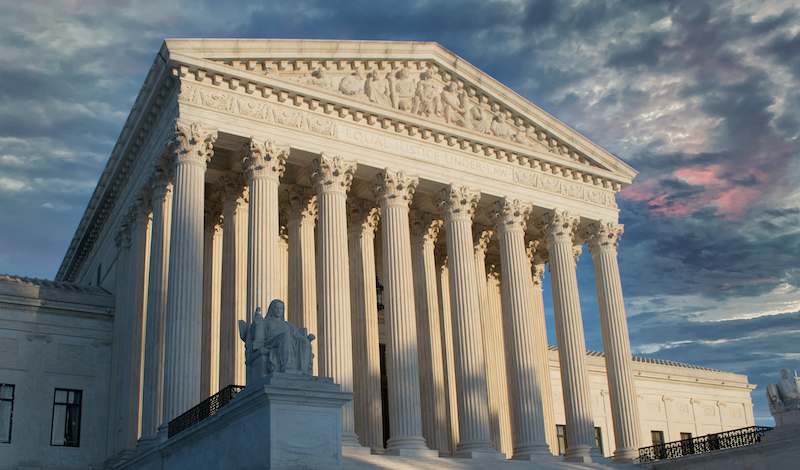
A terrible trio of Supreme Court cases from last term illustrates the need for judicial reform, which can occur through several options.
In a single week in June 2022, at the close of its last term, the U.S. Supreme Court undermined its own political legitimacy through three decisions: New York State Rifle & Pistol Association v. Bruen, Dobbs v. Jackson Women’s Health Organization, and West Virginia v. Environmental Protection Agency. Each of these decisions strikes at a core justification for any government: the need to protect the lives of its people.
Conservative and liberal political theories of different stripes agree that a foundational purpose of government is to preserve the lives and assure the safety of its citizens. They agree that government is justified by the need to preserve civil order through law, ideally through democratic processes, to protect the unalienable right to life.
Protecting the right to life is a primary justification for the consent of citizens to the authority of government in the social contract tradition of Hobbes, Locke, and Rousseau, which informed revolutions establishing democratic republics in the United States and Europe. Since then, long-standing questions have persisted about whose lives matter and who counts as citizens. A foundational principle, however, remains that government must protect the right to life of its citizens to remain politically legitimate.
For this reason, it is shocking to see the Supreme Court acting contrary to the right to life of millions of Americans with respect to gun safety, reproductive health, and climate damage. The Court’s self-inflicted political illegitimacy demands immediate reform.
To begin with some conceptual background, legitimacy is an essentially contested concept in social theory. For purposes here, one can distinguish the following kinds of legitimacy: legal legitimacy, empirical political legitimacy, and substantive political legitimacy.
Legal legitimacy refers to whether the enactment of laws and their application follow agreed standards of rationality and interpretation. The frequent and arbitrary interference of an authoritarian leader in particular cases, for example, would void legal legitimacy.
Empirical political legitimacy refers to whether citizens in a specific government believe law-making and law-applying processes accord with their fundamental values, including, for example, following democratic procedures and trusting judges to act fairly.
Substantive political legitimacy refers to whether a legal and political system adheres to a minimum standard of moral coherence and normative justification of political authority. A regime that deprives a large mass of its citizens of vital rights loses this kind of legitimacy.
Owing to its decisions at the end of its last term, the Supreme Court has lost legitimacy along all three dimensions. Most decisively, the Court has lost its substantive political legitimacy by preventing the government from protecting the right to life of millions of Americans against gun violence, reproductive health risks, and degenerative climate consequences.
My argument that the Court has wrongly decided these cases is not simply a legal or constitutional one. It is an argument based in political and democratic theory that the current Court has lost its substantive political legitimacy, thus mandating its structural reform.
The first instance of the Court’s misfiring came in New York State Rifle & Pistol Association v. Bruen. The Court in this case overturned a century-old New York state gun licensing statute through an expansive interpretation of the Second Amendment. In an earlier decision, District of Columbia v. Heller, the Court had previously struck down a law that prohibited the possession of handguns in the home as a violation of the Second Amendment. But in Bruen, the Court went further to require any gun licensing regime to give citizens a right to meet objective criteria to carry a gun in public.
Purportedly grounded in history, Justice Clarence Thomas’s majority opinion in fact flies in the face of hundreds of years of the government regulating dangerous weapons to keep people safe in their homes, on the streets, in their schools, and in their workplaces. Thomas argues that the Second Amendment enshrines an individual right to carry arms following a tradition going back to the first kings of England. The true history shows a gradual empowering of the state to restrict the public carry of weapons. As one historian explains, Thomas’s opinion is “rambling” and adopts “an almost childlike caricature” of historical method.
More than the bad history and bad law, Bruen is politically illegitimate because of its predictable consequences. It will exacerbate gun violence by impeding federal, state, and local governments from enacting common-sense gun safety regulations to preserve many human lives. Striking down the licensing statute in New York also overturned similar laws in six other states and the District of Columbia, and has thrown into doubt other important gun safety regulations.
The Court has done so at a time when doctors describe gun violence as an epidemic. Justice Stephen Breyer’s dissent provides the grisly details. Simply reciting the names of places of recent gun massacres—Philadelphia, Uvalde, Buffalo, Atlanta, Dayton, Orlando, Charleston, Aurora, Newtown, and more—recalls a toll of many innocent lives lost, including many children. Since 2010, gun-related deaths have increased more than 44 percent. Gun-related deaths now exceed 45,000 annually, surpassing car accidents as a cause of death. The Centers for Disease Control and Prevention reports that 48,832 gun deaths in 2021 is the highest number of gun deaths in 30 years.
The Court’s majority in Bruen is oblivious to the carnage. Justice Samuel Alito, in a concurring opinion, repeats a gun lobby trope about anecdotal cases of “good guys with guns” who foil public assaults. But he fails to grapple with the grim nationwide statistics. Studies show that the “good guy with a gun” is a “statistical unicorn.”
Bruen compounds the Court’s misinterpretation of the Second Amendment in Heller by announcing what is essentially a new constitutional right of vigilantism. The Court refuses to give credence to the post-Heller test developed by eleven Courts of Appeals that balanced the government’s interest in preventing gun violence against Second Amendment rights. Last week, a federal judge illustrated the destructive scope of Bruen by striking down provisions of New York’s post-Bruen gun safety legislation, including the prohibition of guns in “sensitive” areas such as museums, theaters, stadiums, libraries, bars, and even child care facilities.
No modern government can maintain its political legitimacy without keeping its citizens safe from an epidemic of gun violence. As the philosopher Amanda Greene reasons, “legitimacy is not possible while there is open conflict and threat of violence.”
If Bruen threatens the safety of all Americans wherever they may go in public, a second legitimacy-shattering decision endangers the lives of many women.
In Dobbs v. Jackson Women’s Health Organization, the Court struck down the 50-year old precedent of Roe v. Wade. Whatever one may think of the morality of abortion, the problem for the Court’s political legitimacy is that its radical decision will inevitably cause the deaths of many pregnant persons. This choice is ironic, given the Court’s intention to protect “prenatal life.”
The Court heard evidence that reversing Roe and its precedents would cause many deaths from lack of professional medical attention, a return to unclean or improvised abortions, and forcing mothers with serious health risks to give birth. The Court’s majority did not care. Justice Alito, writing for the majority, noted “impassioned and conflicting arguments about the effects of the abortion right on the lives of women,” but then ignored the evidence.
In dissent, Justices Breyer, Sonia Sotomayor, and Elena Kagan observed that Roe and its precedents allowed states to “prohibit abortions after fetal viability, so long as the ban contained exceptions to safeguard a woman’s life or health.” Dobbs now frees the states to adopt any legal restriction beginning at conception, including criminal penalties against mothers and doctors. It recognizes no exceptions for pregnancies resulting from rape or incest, nor for fatal birth defects or complications that risk a mother’s life.
Speaking plainly, the Court has condemned many women to death. Women who carry a pregnancy to term are 14 times more likely to die than when abortion terminates a pregnancy. They are 75 times more likely to die in Mississippi, the state where Dobbs arose. Moreover, researchers have estimated that “a ban on abortions increases maternal mortality by 21 percent, with white women facing a 13 percent increase in maternal mortality while black women face a 33 percent increase.” The Court’s majority has the blood of these women on its hands.
It is one thing to bestow a new constitutional right. It is quite another to withdraw a preexisting, settled right knowing that the decision will kill many people who have relied on it.
At oral argument, Justice Sotomayor asked: “Will this institution survive the stench that this creates in the public perception that the Constitution and its reading are just political acts? I do not see how it is possible.” She is right.
Last but not least, the Court’s decision in West Virginia v. EPA impedes governmental power to address the most difficult and threatening problem that humanity has ever faced: global climate disruption. Once again, the Court undercuts the ability of government to preserve the right to life of present and, in this case, future generations.
The climate emergency is here. As Justice Kagan observes in her dissenting opinion, many deaths are already occurring from an increasing severity of heatwaves, droughts, wildfires, storms, and floods. By the end of the century, human-caused climate disruption may account for as many as “4.6 million excess yearly deaths.” The Court’s majority simply shrugs off the scientific facts of these dangers.
The majority’s arrogance in West Virginia is astonishing. It reaches out to review a moot Obama-era Clean Power Plan, and then creates an entirely new “major questions doctrine” to restrict governmental authority. As Justice Kagan writes, this doctrine appears “magically” as a “get-out-of-text-free card” to “prevent agencies from doing important work, even though that is what the U.S. Congress directed.”
Professor Richard Revesz confirms that the new major questions doctrine announced in West Virginia, and effectively applied in an earlier case National Federation of Independent Business v. Department of Labor, “casts an ominous pall over the nation’s regulatory future.” Even though Congress acted in August to re-empower the EPA by adopting a statute overturning the effect of West Virginia with respect to the agency’s authority to regulate greenhouse gases, the new major questions doctrine will continue to impede effective climate and other health-related policies.
As in Bruen and Dobbs, the Court’s new doctrine announced in West Virginia will kill people. Taken together, the cases count three strikes against the Court’s political legitimacy by preventing the political branches from acting to protect the basic right to life of its citizens.
One may also assess the legal legitimacy of these decisions as “egregiously wrong.” Bruen extends a wrong-headed originalist interpretation of the Second Amendment and adds historical errors. Dobbs lacks “any coherent legal analysis” on the merits and violates the principle of stare decisis, overturning the 50-year old precedent of Roe as well as the 30-year-old “precedent on precedent” of Planned Parenthood of Southeastern Pennsylvania v. Casey. And West Virginia conjures a brand new “major questions doctrine” to prune the authority of the administrative state.
My argument here, however, does not focus on the weaknesses in the Court’s constitutional interpretation or legal methodology. A deeper, unifying feature of these cases is that they are politically illegitimate because they subvert the government’s authority to protect citizens’ lives with respect to gun violence, reproductive health, and climate damage.
Not surprisingly, these decisions are unpopular with the public, eroding the Court’s political empirical legitimacy as well. Public opinion polls show the Court at its lowest approval ratings on record. In the latest Gallup survey, a record low of only 47 percent of Americans say they trust “the judicial branch headed by the U.S. Supreme Court.” Only 40 percent approve of how the Court is doing its job.
The Court’s loss of both substantive and empirical political legitimacy means that the “quality assent” of citizens needed to justify it has vanished. A major political structural adjustment is therefore required. A Supreme Court that has lost its political legitimacy must be reformed. Otherwise, our government as a whole could lose legitimacy, tilting the political world toward chaos.
Although it is rare, this is not the first time in history that the Court has launched itself into political illegitimacy. And the political branches, Congress and the President, have corrected the Court’s course before.
There are two important historical precedents. The first followed the Court’s worst decision ever, Dred Scott v. Sandford, which held that no enslaved or free black person had federal constitutional rights. Dred Scott sparked the Civil War, and its breach of legitimacy was repaired only by the recognition of rights in the Thirteenth, Fourteenth, and Fifteenth Amendments, along with the federal civil rights statutes adopted in the 1960s.
Another low moment for the Court occurred when it repeatedly struck down many statutes passed in the early days of President Franklin D. Roosevelt’s New Deal.
In these previous moments of lost judicial legitimacy, the political branches responded. During the Civil War, Congress increased the number of Supreme Court justices to ten, giving President Abraham Lincoln another appointment, and Congress then reduced the number to seven to prevent President Andrew Johnson from appointing justices to undo Reconstruction—which, unfortunately, later occurred anyway.
Responding to the Court’s evisceration of the New Deal, President Roosevelt threatened to appoint as many as six additional justices, depending on how many sitting justices reached the age of 70. This threat encouraged “the switch in time that saved nine” when a few justices changed their tune and upheld New Deal legislation.
The United States faces another constitutional legitimation crisis today. Fortunately, there is a menu of choices available to address it. The Presidential Commission on the Supreme Court of the United States issued a report in December 2021 examining options for reform.
In reviewing the options, any reform should meet two conditions. First, statutory interventions rather than constitutional amendments are needed because there is no time for a constitutional amendment. Second, any reform when adopted must dislodge the current majority that is acting illegitimately.
Here are three specific options that could be adopted singly or in combination.
1. Expand the Court to 13 justices. The power of Congress to alter the number of justices on the Court is long established as constitutional. The number of justices has fluctuated historically between a minimum of five and a maximum of ten, and the Commission determined that “there is widespread agreement among legal scholars that Congress has the constitutional authority to expand the Court’s size.” Law professors and former judges—including Michael Klarman, Mark Tushnet, Nancy Gertner, and Laurence Tribe—support expanding the membership of the Court.
Expanding the Court to 13 justices would counter the Machiavellian machinations of Senator Mitch McConnell. As Majority Leader, McConnell refused even to hold hearings on President Barack H. Obama’s appointment of Merrick Garland. McConnell later rushed through a confirmation of President Donald J. Trump’s appointment of Amy Coney Barrett, thus arguably stealing two appointments for Republicans. Giving President Joseph R. Biden the power to appoint four justices would rebalance the Court to a seven-six Democratic-to-Republican ratio.
Other justifications to expand the Court include increasing the number of justices to handle an increasing workload, returning to a tradition of one justice for each court of appeals, and conforming to the numbers of judges on the highest courts of other democratic governments in the world, which range from seven to 18.
2. Establish 18-year term limits for justices. Federal judges have a constitutional right to lifetime appointment, but this does not mean that Congress cannot set term limits specifically for the Supreme Court. As the Commission on the Supreme Court recognizes, rotation systems are possible. Retroactively imposing an 18-year term limit would require Justice Thomas to retire immediately, Chief Justice John Roberts in 2023, and Justice Alito in 2024.
Two thirds of Americans favor terms limits for the Court’s justices, according to a recent poll.
3. Set a mandatory retirement age of 75. Following the same logic that lifetime judicial appointments do not necessarily entail lifetime appointments to the Supreme Court, Congress could set a retirement age of, say, 75. Retired justices could remain active as senior judges by special designation to lower courts or as special masters. Setting a retirement age of 75 would require Justice Thomas to retire next year, Justice Alito in three years, Justice Sotomayor in seven years, and Chief Justice Roberts in eight years.
The Commission’s report reviews other alternatives as well, including jurisdiction stripping, a supermajority requirement for constitutional review of statutes, legislative overrides, a mandatory code of judicial ethics, and recusal rules for conflicts of interest. Other creative options include a “Supreme Court lottery” that entails randomly drawing Supreme Court panels for each case from a pool of all appellate judges, and a “balanced bench” comprising five justices appointed by Democrats, five by Republicans, and five by the ten politically appointed justices.
One might argue that rejiggering the structure of the Court may also have detrimental consequences for its legitimacy, causing it to become even more political or politicized. The United States, however, stands very far away today from dreams of “neutral principles.” The Court’s illegitimacy has become not just legal or even political; it is now existential.
At a conference last month, Chief Justice Roberts said, “I don’t understand the connection between opinions that people disagree with and the legitimacy of the Court.” He confuses legal legitimacy and political legitimacy. The problem is not just that the Court is getting the law wrong. Worse even than acting as “politicians in robes,” the Court’s current majority is taking an axe to a foundational root of the political legitimacy of government: the power to protect the right to life of its people.
Because the Court has become the “most dangerous” branch, “arrogantly heedless of the human and environmental consequences of the jurisprudence it so ruthlessly imposes,” it must be stopped. Congress and the President must determine the exact mode of reform, but some effective change of the Court’s structure is essential to restore its political legitimacy.




